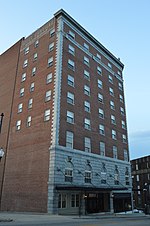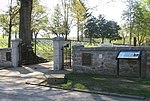Danville Municipal Building
Buildings and structures in Danville, VirginiaCity and town halls on the National Register of Historic Places in VirginiaGovernment buildings completed in 1926Individually listed contributing properties to historic districts on the National Register in VirginiaNRHP infobox with nocat ... and 3 more
National Register of Historic Places in Danville, VirginiaNeoclassical architecture in VirginiaSouthern Virginia Registered Historic Place stubs

Danville Municipal Building is a historic city hall building located at Danville, Virginia, USA. It was built in 1926 and is a three-story, brick and concrete building faced in limestone in the Classical Revival style. Its front facade has a colonnade with Ionic order columns.It was listed on the National Register of Historic Places in 1995. It is located in the Downtown Danville Historic District and Danville Tobacco Warehouse and Residential District.
Excerpt from the Wikipedia article Danville Municipal Building (License: CC BY-SA 3.0, Authors, Images).Danville Municipal Building
Patton Street, Danville
Geographical coordinates (GPS) Address Nearby Places Show on map
Geographical coordinates (GPS)
| Latitude | Longitude |
|---|---|
| N 36.586111111111 ° | E -79.391944444444 ° |
Address
Municipal Building
Patton Street 427
24541 Danville
Virginia, United States
Open on Google Maps









